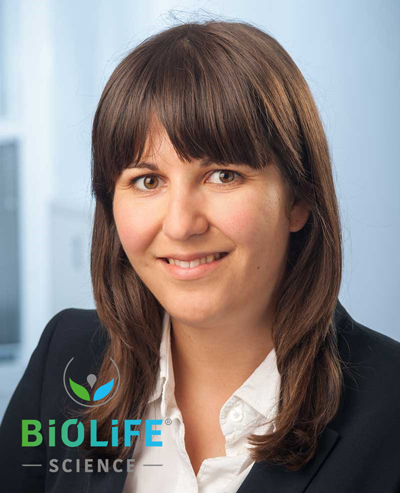
Natural Astaxanthin and its Effect in Cosmetic Applications
Interview with Dr. David Hauck, Consultant on the use of natural astaxanthin
BDI-BioLife Science
Dr Hauck, you use a new active ingredient called “astaxanthin” in your “Better Aging” skin care products. Could you please tell us what natural astaxanthin is?
Astaxanthin is a fractionated algae extract that is derived from the microalga Haematococcus pluvialis. The microalga produces astaxanthin for self-protection, for example when exposed to great heat, nutrient deficiency or other threatening living conditions. We use this mechanism of action in cosmetics.
The active ingredient belongs to the group of carotenoids and is a very potent, biologically effective antioxidant. Antioxidant potential is measured using various scales such as ORAC or ESR, although the ratio does not allow any statement about the antioxidant capacity in correlation to the biological effect. For example, ascorbic acid – i.e., vitamin C – has very high antioxidant potential but little biological antioxidant effect.
In any case, astaxanthin is a very potent antioxidant in terms of biological effect and one of the most potent antioxidants.
What is the effect of astaxanthin on the human skin?
We have already conducted a large number of studies regarding the effects of astaxanthin, but there is still a long way to go in terms of its exact cascade of action. What is known is that astaxanthin is stored in the cell where it is stabilized and where it reacts to the formation of free radicals. A distinction is made between exogenous radicals (such as sunlight or environmental pollution) and endogenous radicals which are formed directly in the body through metabolism (poor diet, alcohol consumption) or due to stressful situations.
When stored in the cell, astaxanthin forms a protective shield. Our studies have shown that astaxanthin inhibits the formation of free radicals caused by UV rays by up to 100%, which is a great result. The most important thing to remember about sun care is that UV filters only protect against UVA and UVB rays. So, a skincare product with astaxanthin functions as complementary protection to sun care.
Apart from UV light, we have also tested hydrogen peroxide as radical formers. This test has shown that regeneration occurs even in already damaged cells. However, astaxanthin’s preventive power of is much more dominant than its regenerative effect.
The measurement results regarding skin tolerance were extremely positive, especially concerning sun exposure. Through the functional groups, we were also able to establish correlation properties regarding moisture and transepidermal water loss.
As a preventive application, astaxanthin is very beneficial, especially in the field of sun care, but in the long term, it is particularly convincing for anti-aging products. The effects of free radicals shall be mitigated as they lead to degradation of the skin’s collagen-supporting tissue.
The results of our tests show that astaxanthin is very versatile and provides great results especially in the prevention of skin damage, whether sun care, anti-pollution or anti-aging care.
Why do you rely on natural astaxanthin in your formulations and what is your focus when processing the raw material?
I was amazed by astaxanthin’s effect because it naturally counteracts and repairs skin damage. When processing active ingredients, factors such as the quality of raw material and the effect of ingredients matter to me but handling also plays a role. From logistics and storage to processing: consistent high quality and stability of the active ingredients, and thus, the end product are top priorities.
In addition, a raw material must be easy to dose and easy to incorporate into the active ingredient phase of a formulation. A very positive side effect with astaxanthin is that you can see the active ingredient due to its color – the products have slight apricot and rosé shades, which means an exciting customer experience because there is “a visual effect”. Don't worry, the active ingredient does not stain but still gives the skin a fresh complexion.
What must be considered when formulating? How is astaxanthin dosed properly?
For my cosmetics line, I use AstaCos®, an oleoresin which contains astaxanthin, dissolved in high-quality jojoba oil and has very good stabilities. Other suppliers use milk thistle or olive oil as a base for their astaxanthin oleoresins but cannot compete in terms of stability.
The oleoresin should be incorporated either into an oil base or directly into the finished emulsion. Compared to a powder that is sprinkled in, it dissolves easily with both options. Especially in closed processes, the oleoresin can be absorbed and processed well via vacuum.
When it comes to dosage, it is important to know that AstaCos® is very profitable with a range of 0.01% to 0.1%, but the dosage ultimately depends on the end product, for example pure oil care or an emulsion.
We have developed a pure oil product, a vitamin oil booster, especially for winter, when the skin must cope with cold as well as dry heating air. In summer, on the other hand, we focus on additional protection against UV rays with a DNA repair serum. These are two ways to protect the skin against heat as well as cold.
Where do you get your natural astaxanthin? What are the differences in quality?
For my cosmetic line, I use AstaCos® from BDI-BioLife Science. Since raw materials and active ingredients produced sustainably and, if possible, regionally are important to me, I picked astaxanthin from the Austrian company. Consistent active ingredient quality, availability and easy handling are other important criteria. Therefore, it is great to have a European supplier from the German-speaking region that focuses on quality and produces sustainably.




